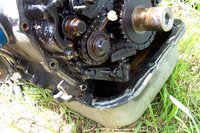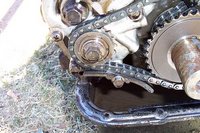Difference between revisions of "Self adjusting bs chain"
m (Protected "Self adjusting bs chain" [edit=sysop:move=sysop]) |
Cartman02au (talk | contribs) |
||
| Line 8: | Line 8: | ||
[[Category: 2.6L Technical]] | [[Category: 2.6L Technical]] | ||
| − | [[Category: First Generation]] | + | [[Category: First Generation Magna]] |
| − | [[Category: Second Generation]] | + | [[Category: Second Generation Magna/Verada]] |
Revision as of 01:20, 11 January 2010
From around 1990 onwards the Astron II engine was fitted with a hydraulic self-adjusting mechanism for the balance shaft chain in an attempt to supress chain noise. This change appeared on both the original Astron II and the revised Astron II.
The self-adjusting mechanism (see figure 1) is fitted where the former lower chain guide used to be placed (see figure 2). The self-adjuster runs off of oil pressure which pushes out the tensioner that holds the chain tight. Unlike the main timing chain tensioner, the balance chain tensioner does not include a "ratchet" mechanism to hold the tensioner in place when oil pressure is lost (e.g. when the engine is switched off), therefore the tensioner doesnt tension the chain when there is low oil pressure (like at startup) and can cause the chain to rattle. This is why it is common for Astron II engines fitted with the self-adjuster to rattle at startup and then quieten down after a few seconds.
Oddly enough there is still provision to adjust the balance shaft chain manually. Mitsubishi state that this should only occur if the chain guides and tensioner have been moved or under "high mileage conditions". It is believed that the chain tension should only be modified using the old method after the cause of the slackness is investigated. If the chain is excessively worn it should be replaced.

